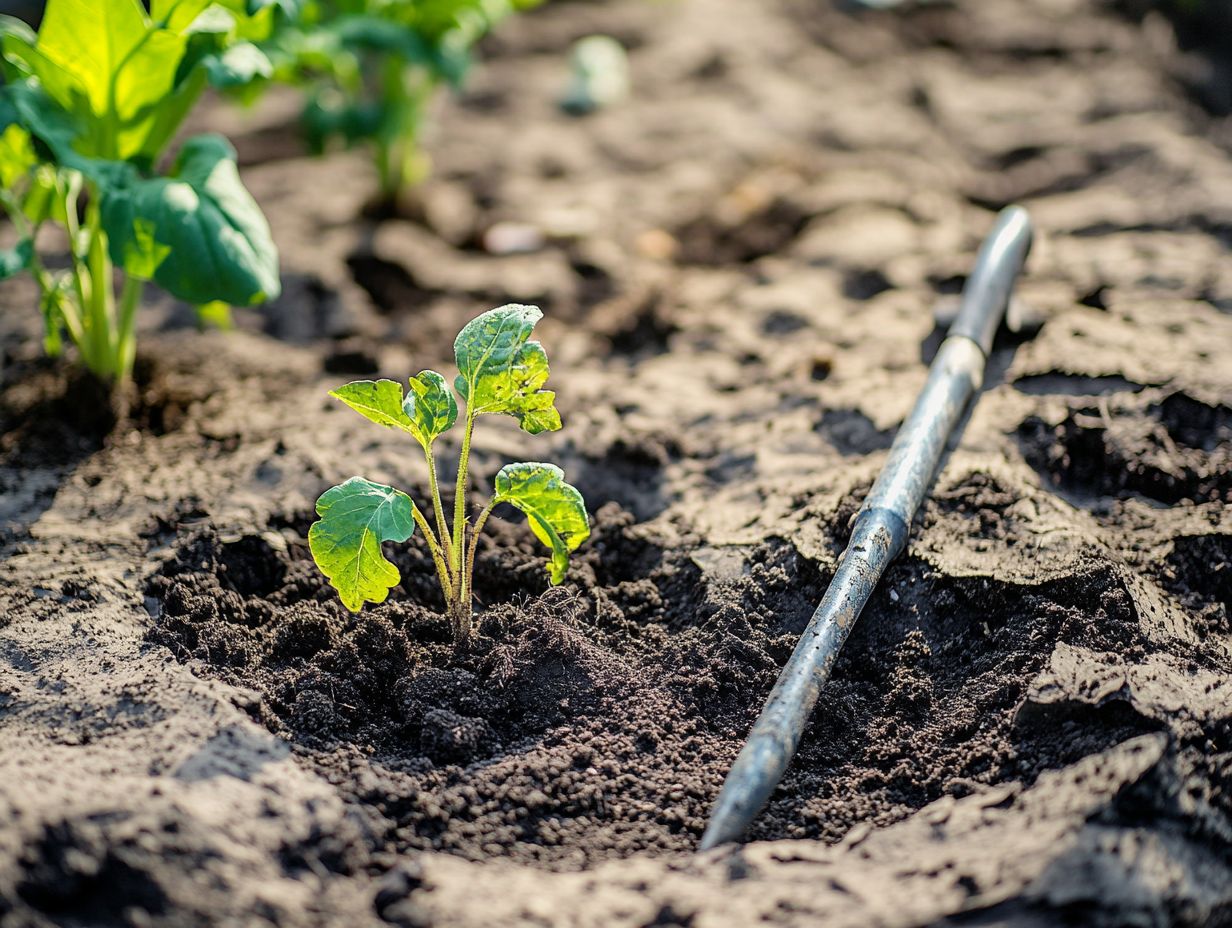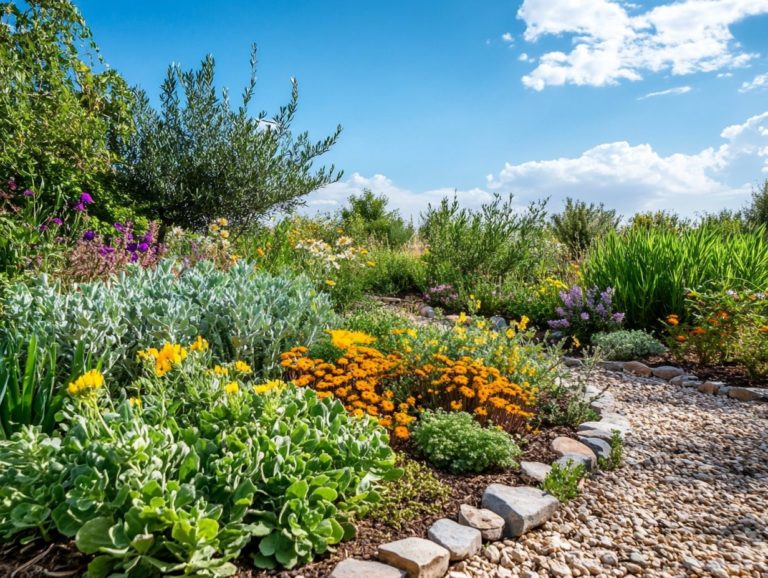Understanding Soil Health in Drought Gardening
In an age where drought conditions are becoming all too familiar, understanding the importance of soil health in your gardening endeavors is essential.
Healthy soil sustains plant life and plays a pivotal role in water retention, making it indispensable for flourishing gardens during dry spells. Join us as we explore the exciting world of soil health, identifying signs of its decline and presenting effective strategies for rejuvenation.
Additionally, you ll learn how to select drought-resistant plants that can thrive in challenging conditions.
You’ll discover efficient watering techniques and other vital considerations to ensure your garden thrives despite the challenges posed by drought. Start transforming your garden today and watch it thrive!
Contents
- Key Takeaways:
- The Importance of Soil Health in Drought Gardening
- Signs of Unhealthy Soil
- Identifying Soil Issues in Drought Gardening
- Improving Soil Health in Drought Gardening
- Strategies for Maintaining Healthy Soil
- Choosing Drought-Resistant Plants
- Types of Plants That Thrive in Dry Conditions
- Watering Techniques for Drought Gardening
- Other Considerations for Drought Gardening
- Frequently Asked Questions
- What is soil health and why is it important in drought gardening?
- Does soil health affect the types of plants I can grow in a drought garden?
- How can I improve soil health in my drought garden?
- Can I use chemical fertilizers in a drought garden?
- How often should I water my drought garden to maintain soil health?
- Can I still have a healthy and productive garden during a drought?
Key Takeaways:

- Soil health is crucial in drought gardening as it helps plants withstand extreme dry conditions.
- Signs of unhealthy soil include compacted, dry, or nutrient-deficient soil, which can be remedied through proper soil management strategies.
- Choosing drought-resistant plants and implementing efficient watering techniques can help maintain a healthy garden in times of drought.
The Importance of Soil Health in Drought Gardening
Soil health is critical in drought gardening because it directly impacts how resilient your plants will be during dry spells. Additionally, using cover crops in drought gardening can play a vital role in cultivating healthy soil, rich in organic matter and diverse soil organisms, significantly enhancing its ability to store water.
This boosts the activity of tiny organisms in the soil and supports nutrient cycling essential for robust plant growth. Experts like Dr. Bianca Moebius-Clune from USDA NRCS emphasize that prioritizing healthy soil is vital for fostering drought resilience in farming methods.
Adopting cover crops improves your soil s structure and function, facilitating effective water infiltration and minimizing the risk of compaction.
Why Soil Matters in Drought Conditions
Soil is vital for maintaining agricultural productivity, especially during challenging drought conditions. It acts as a reservoir for the water and nutrients essential for plant growth.
Healthy soil enriched with organic matter enhances its capacity to retain moisture crucial for crops during prolonged dry spells. This well-maintained soil also acts as a natural carbon sink, helping mitigate the impacts of climate change.
However, practices like tillage or deforestation can disturb soil integrity, leading to reduced water retention and increased erosion, which can be detrimental to your gardening efforts.
Implementing erosion control measures, such as cover cropping and contour plowing, preserves soil structure and enhances its resilience against water scarcity, ensuring sustainability even in challenging climatic conditions.
Signs of Unhealthy Soil
Identifying signs of unhealthy soil is crucial for improving your gardening results, especially in drought conditions where soil health plays a pivotal role in plant resilience and productivity.
Look for indicators such as poor water infiltration, diminished microbial activity, and visible soil compaction; these can lead to nutrient deficiencies and restrict root growth.
Engaging in soil testing uncovers imbalances in soil structure and reveals essential soil bacteria, equipping you with the knowledge needed to take corrective actions.
By recognizing the symptoms of unhealthy soil, you can implement effective management strategies to improve soil health and support sustainable gardening practices.
Identifying Soil Issues in Drought Gardening
Identifying soil issues in drought gardening is essential for maintaining optimal growing conditions. For more information, check out the best resources for drought gardening, which ensures your plants receive the necessary water and nutrients.
Monitoring the soil’s moisture retention is key. Poor water storage can stress your plants during dry spells. Take a moment to observe the texture and structure of your soil. Compacted soil can severely impede drainage and aeration.
You might notice signs of inadequate nutrient cycling, such as yellowing leaves or stunted growth. These indicate that essential nutrients aren t circulating properly.
Don t overlook the role of soil organisms. Their presence or absence is crucial for overall soil health. Without beneficial microbes and insects, your soil can become imbalanced, leading to more challenges in your garden.
Improving Soil Health in Drought Gardening

Improving soil health in drought gardening is crucial for enhancing water retention. Incorporating native plants in drought gardening also promotes microbial activity, ensuring your plants thrive despite limited water availability.
To achieve this, focus on increasing organic matter by adding compost and incorporating cover crops. These practices improve soil structure while preventing erosion.
Regular soil testing offers valuable insights into nutrient requirements. It guides your amendments, setting the stage for sustainable gardening in challenging conditions.
Strategies for Maintaining Healthy Soil
Healthy soil is the foundation for a thriving garden! It boosts sustainability and productivity, especially in drought conditions. By employing the right strategies, you can significantly enhance soil moisture retention and boost overall plant health.
Embracing a diverse range of plant species is crucial. It’s the key to fostering a balanced ecosystem that enhances nutrient cycling and builds resilience against pests.
Utilizing cover crops is another practical measure. They protect your soil from erosion while increasing its water-holding capacity. This dual approach nurtures the soil and enhances its structure.
Start implementing these strategies today for a healthier garden!
- Rotate your crops.
- Incorporate organic matter like compost.
- Choose plant varieties suited to your local climate.
In doing so, you will create a vibrant and sustainable growing environment.
Choosing Drought-Resistant Plants
Selecting drought-resistant plants is essential for achieving success in drought gardening. These species are naturally adapted to thrive in conditions with limited water availability, fostering healthy soil organisms and promoting overall ecosystem vitality.
Types of Plants That Thrive in Dry Conditions
Several types of plants flourish in dry conditions, making them outstanding choices for drought gardening especially native species that have expertly adapted to your local climate and soil.
Take, for example, the resilient Agave americana. It is renowned for its thick leaves, acting like nature s water reservoirs. The native California poppy adds a splash of vibrant color while thriving on scant rainfall.
Consider non-native options like the ornamental grasses of the Miscanthus genus. They showcase remarkable adaptations, including deep root systems that tap into underground moisture sources.
These drought-resistant plants enhance soil health by reducing erosion and supporting beneficial soil organisms. They create a welcoming environment for microorganisms that enrich the ecosystem. Their unique structures and growth habits make them champions for sustainable gardening in arid regions.
Watering Techniques for Drought Gardening
Implementing effective watering techniques is essential for drought gardening. These methods maximize water storage in the soil and minimize waste, ensuring that optimal moisture levels are maintained for your plants.
By adopting these strategies, you can cultivate a thriving garden even in challenging conditions.
Effective and Efficient Watering Methods

Effective and efficient watering methods are crucial in drought gardening. They ensure your plants receive the hydration they need while promoting soil health and minimizing evaporation.
One of the most impactful techniques is deep watering. This method encourages roots to dive deeper into the soil, making your plants more resilient during dry spells. Schedule your watering sessions for the early morning or late afternoon to significantly cut down on water loss due to evaporation.
Incorporating mulch into your garden beds retains moisture in the soil. This enhances hydration levels and promotes better plant growth.
Together, these strategies foster healthier plant growth and improve the overall structure and fertility of the soil. A well-structured soil can better handle the challenges of drought conditions.
Other Considerations for Drought Gardening
Regarding drought gardening, your considerations should stretch beyond just choosing the right plants and mastering watering techniques. It’s essential to develop a complete understanding of soil health and recognize its vital relationship with ecosystem resilience, especially as we navigate the challenges posed by climate change.
Additional Factors to Keep in Mind for Successful Gardening
For successful gardening, especially in drought-prone areas, consider additional factors that contribute to the health of your soil and ecosystem.
Understanding the vital role that soil organisms play is crucial for maintaining soil fertility. For instance, earthworms aerate the soil, improving water retention and promoting robust root growth.
Microorganisms work tirelessly to break down organic matter, releasing essential nutrients. By nurturing a vibrant biological community underground, you can enhance your garden’s resilience against the stresses brought on by changing climate conditions.
Implementing climate adaptation strategies like mulching and composting supports these beneficial organisms. This creates an environment where your plants can not only survive but truly thrive amidst unpredictable weather patterns.
Frequently Asked Questions
What is soil health and why is it important in drought gardening?
Soil health refers to the overall condition and quality of the soil, including its physical, chemical, and biological properties. Healthy soil can better retain moisture and support plant growth, even during periods of limited water availability.
Does soil health affect the types of plants I can grow in a drought garden?

Yes, soil health plays a crucial role in determining which plants can thrive in a drought garden. Plants adapted to drought conditions and with deep root systems are more likely to do well in soil with good water retention and nutrient availability.
How can I improve soil health in my drought garden?
There are several ways to improve soil health in a drought garden. You can add organic matter such as compost or mulch to increase water retention and nutrient levels, and knowing what tools are essential for drought gardening can also enhance your efforts.
Using cover crops to protect and nourish the soil is also beneficial. Avoid tilling or excessive watering, as these can disrupt the soil’s natural balance.
Can I use chemical fertilizers in a drought garden?
While chemical fertilizers may provide quick results, they can harm soil health in the long run. This is due to depleting beneficial microbes and disrupting the soil’s structure.
It’s advisable to use organic fertilizers and amendments in a drought garden, as they can improve soil health over time.
How often should I water my drought garden to maintain soil health?
The frequency of watering in a drought garden will depend on various factors such as the type of plants, soil type, and climate. Water deeply, but only a few times this method empowers your plants to send roots deep into the soil!
Observe your plants and the soil moisture levels to determine the best watering schedule for your garden. Start implementing these tips today and watch your garden thrive!
Can I still have a healthy and productive garden during a drought?
Absolutely! You can maintain a vibrant garden even during dry spells.
Choose plants that thrive on little water, often called drought-resistant plants. Improve your soil, use mulch, and be mindful of water usage to keep your garden flourishing.






